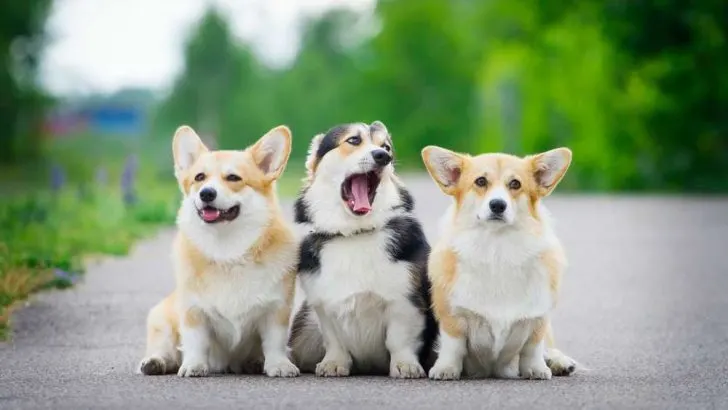The corgi breed comes in different colors, and that is part of what makes them even more attractive and unique. Besides the fact that there are two main breeds: the Pembroke and the Cardigan Welsh corgi, there are even more shades in which they come.
Corgi colors vary according to the breed you are dealing with. It can go from one to three colors. No matter if your corgi is considerably black, sable, or even red – he is definitely cute.
By reading this article, we will lay down all the possible colors and shades of your corgi and many more interesting facts regarding this breed.
So, stay tuned!
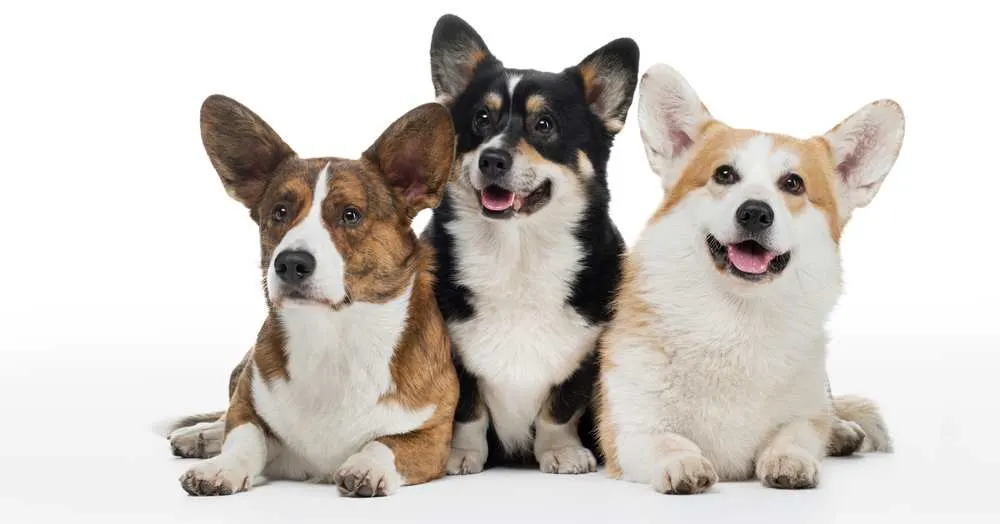
How Corgi Colors Change?
When do corgis change color? when do corgis stop changing color?
For starters, there are 5 basic colors corgis come in, and they are:
- Red
- Black
- Sable (this is a lighter shade of brown, close to the color of sand)
- Blue
- Brindle (the base color is brown overlain with dark brown or black stripes)
However, there is a little difference between the breeds and the colors that prevail. Let’s take a closer look at what you can expect from the two:
| The Pembroke Welsh Corgi | The Cardigan Welsh Corgi |
|---|---|
| Red | Black |
| Red-headed tri-color | Blue merle |
| Black-headed tri-color | Brindle |
| Sable | Red |
| Sable |
- A red-headed tri-color corgi has red across his ears, around his eyes, and on the top of his head.
- A black-headed tri-color corgi has black on his head and around his eyes. This silly color pattern can make him look like a raccoon.
- When it comes to the sable colored corgis, this is actually a mix of different shades (reddish, brownish, and black) all across his body – including the little tail. You will often find a black marking on the eyes of a sable corgi. And this reddish color can sometimes seem like chestnut.
- Black corgis are predominantly black with little white marking on their body, usually on their coat’s downside.
- A blue merle corgi is an interesting sight to see. This color is very unique, and it will appear gray in day sunlight. Corgis with this color often have blue eyes, which makes them even more attractive.
- A brindle colored corgi will have a brown coat with dark brown or black stripes across it. People often call this “the tiger coat”.
- A red corgi is a mixture of red and white. Just like the black colored corgi, the top of the body will be red, and the bottom part will have white markings.
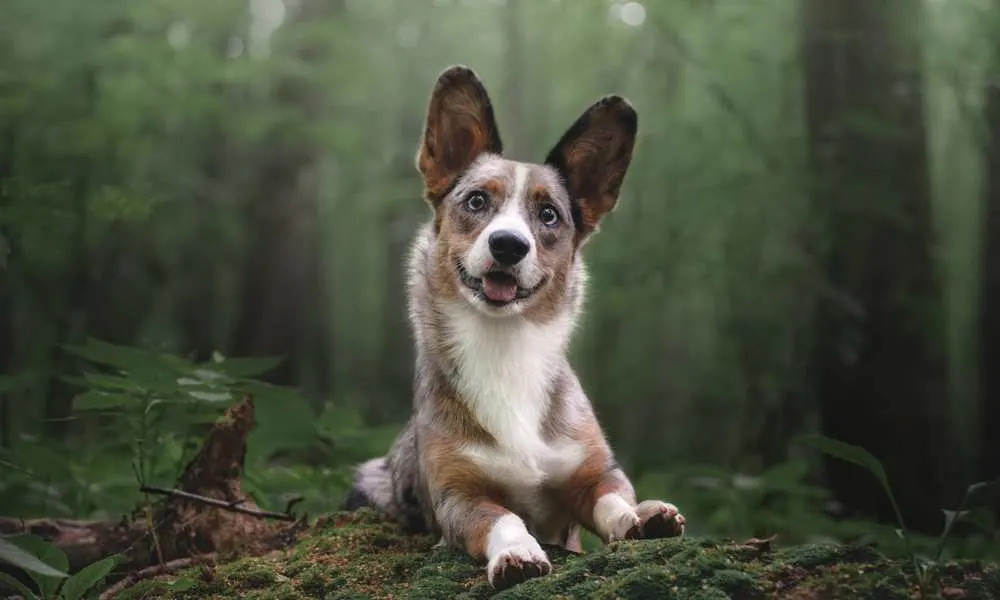
Corgi Markings: Can Corgis Be Black And White?
Now that we have laid down all the possible colors let’s take our attention to some of the most common corgi markings.
- Black mask: the dog has black markings on his face, which resembles a mask. This is most common for black corgis.
- Brindle points: this refers to brindle stripes across the corgi’s coat.
- Tan points: you can find the so-called tan points on your corgi’s paws, muzzle, tail, and chest.
- Ticked markings: these markings resemble “holes” on your corgi’s coat, and they are usually the color white.
- White markings: this includes your corgi having white patterns on his body, also known as white spotting, and they will usually be found on the downside of your corgi’s coat.
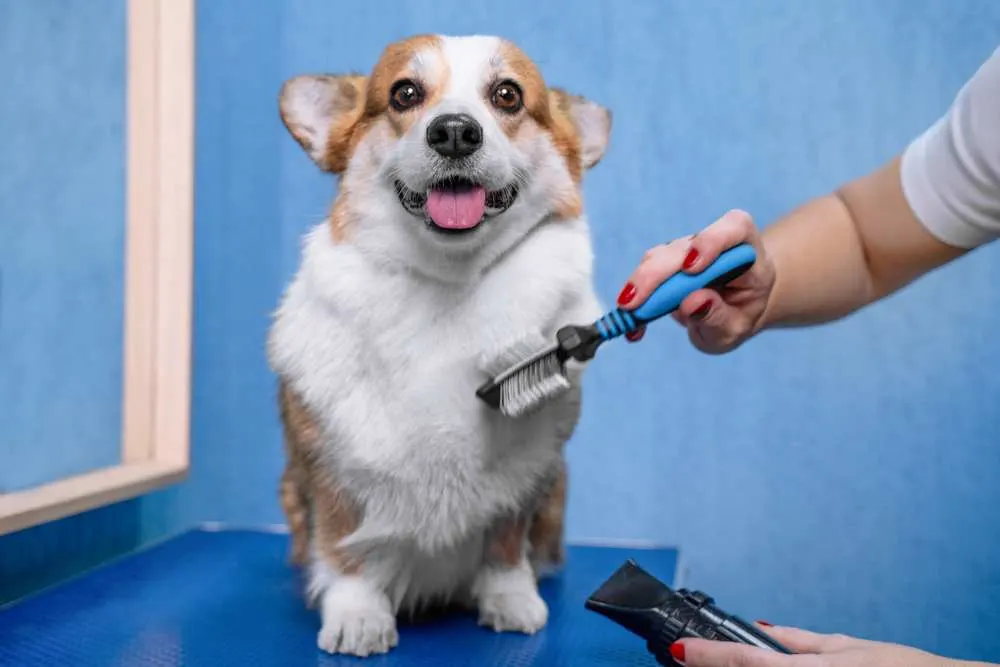
Corgi Grooming Guide
Corgis are double-coated dogs, and their fur needs a lot of attention. They also shed a lot during the year, which means that there will be many hairs if you don’t groom your corgi correctly and in time.
The good news is that you can do this at the comfort of your own home, with both the Pembroke and Cardigan Welsh corgi.
We are here to show you the steps:
1. Inspection of the dog
Before starting the grooming process, you should inspect your corgi from head to toe. You will have a better feel of this when you pat and rub him a bit. It would be best if you also were on the lookout for any noticeable bumps, lumps, or scars on the corgi’s body.
Take a small brush and get rid of any excess hair, if there is any.
2. Brushing the corgi
Take a medium-sized brush or any other that your vet has recommended, and brush your corgi’s entire body for a couple of minutes. You need to take your time and brush your corgi’s coat carefully and thoroughly.
Pay extra attention to the areas in which there are more tangles, and be sure to take the dog’s collar off before you start – this can get in the way of proper brushing around the neck’s area.
When you are preparing to brush your corgi, you should check in advance for any possible skin rashes, redness, or irritation.
3. Bathing
Corgis should have frequent baths because of their double-coat – it is very thick, and it can pick up a lot of unwanted materials, including bacteria. The bathing schedule should be the most frequent during the shedding season.
This way, you will keep your corgi clean and your home dog hair-free. As far as dog shampoos are concerned, you can get them anywhere on Amazon for a reasonable price. However, if you decide to use shampoo, remember to rinse. You will also need a bigger towel to dry your corgi.
4. Cleaning Their Ears and Teeth
Ear cleaning is essential in dog hygiene. It is a place where most bacteria are piled up and also the most common place for a flea to strike. Some people recommend using cotton balls to clean out your dog’s ears, but this doesn’t apply to all breeds because of their ear shape.
Teeth hygiene is also of great importance for your corgi. His teeth are susceptible, and they can be the focus of many serious diseases. For that reason, your corgi’s teeth should be washed at least once a week. Also, pay attention to what he consumes.
5. Nail clipping
Although this process is mainly not approved by dogs, and they absolutely hate when you come close with scissors, it is necessary that you get their nails clipped from time to time.
Dog nails don’t grow as fast as human nails do, so you can say that once a month is a reasonable time frame for a nail clipping session. Be careful not to get hurt, and keep in mind that corgis can get impatient!
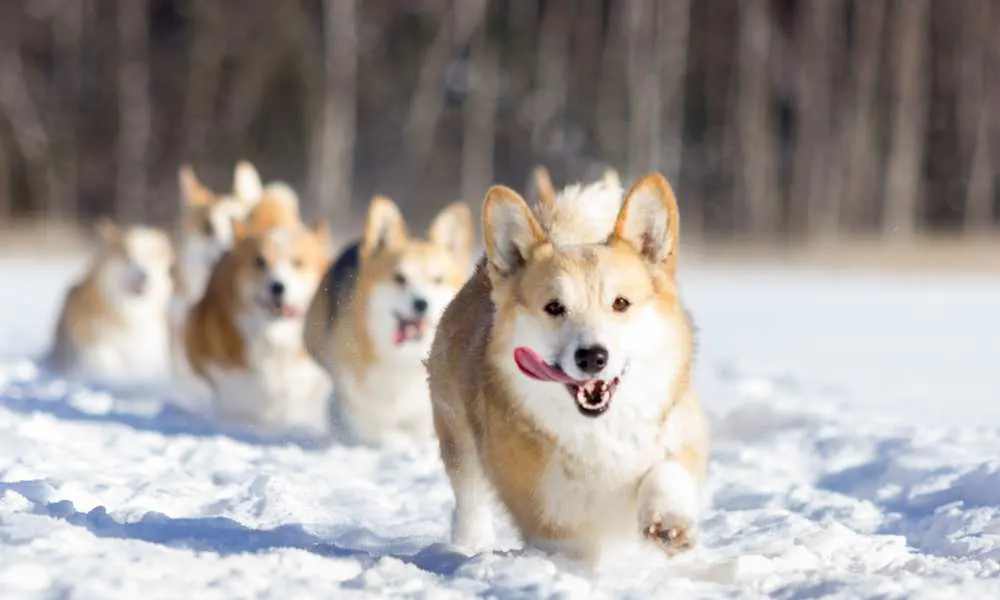
Hairstyles
If you decide to take your corgi to a professional to get him trimmed, there are a couple of hairstyles that corgis are known for. Basically, your corgi can rock three hairstyles: the fluffy, natural, or modest trim look.
1. The Fluffy Look
If your corgi has a typically long and thick coat, then you should go with the fluffy look. This trims the hair a bit, but it doesn’t change the overall look, which is very important. This hairstyle will make your corgi look chubby and “full of attitude” at the same time.
2. The Natural Look
Most people like to keep it natural, and this goes for their pets as well. This hairstyle doesn’t require frequent visits to the dog salon – this involves just slight cuts around the ends of their coat to make them look neat. The natural look will surely make your corgi feel more comfortable during the summer and winter when they heavily rely on their coat.
3. The Modest Trim
A modest trim is a hairstyle that involves trimming most of your corgi’s body while leaving just certain parts, like the space around the ears and muzzle fluffy. This is an excellent choice because it still offers that fluffy look, but you no longer have trouble with cleaning that thick coat after a play-date at the park.
Just like human, dog fashion changes, and there will always be new ideas emerging. These three hairstyles, however, are the basis and for those who like to keep it simple.
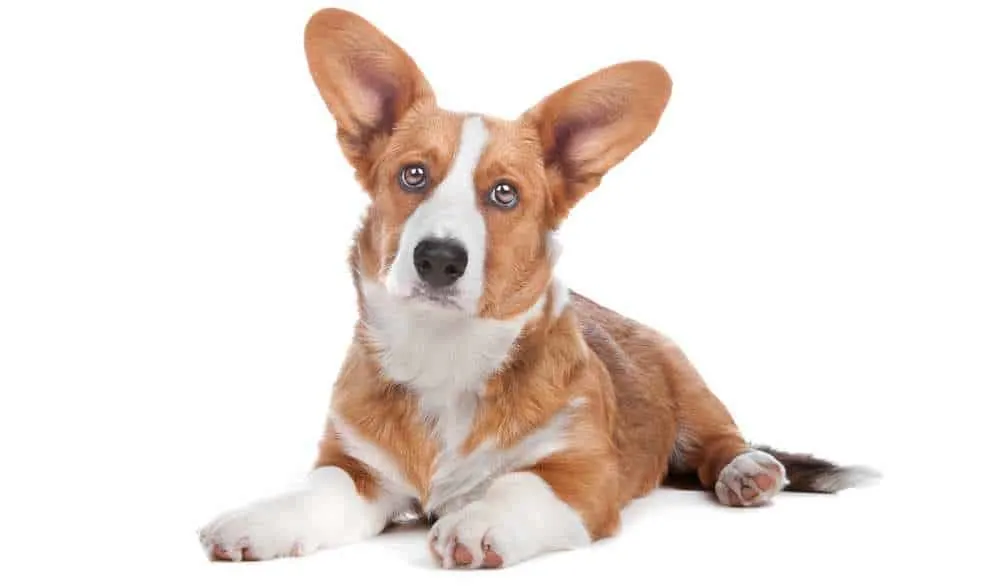
Corgi Cattle Dog
Besides the two primary corgi breeds, there is one more – The Corgi Cattle Dog. This is a mixture of the Pembroke Welsh Corgi and an Australian Cattle dog. They also go by the name of “Cowboy Corgi.” The mix of these two genes gives the cowboy corgi a variety of colors and other personality traits.
The cowboy corgi is not much taller than the regular Cardigan or Pembroke corgi – from 13 to 20 inches. They come in a variety of colors: red, brown, blue, white, and black.
Like their parents, these are highly intelligent dogs, and they need to be active or have some kind of “job” to stay healthy. Although they inherited their small legs from the Pembroke corgi, they are still very friendly.
Here is some essential information you should know before buying this breed:
The cowboy corgi rarely barks.
This could be considered as an advantage because of the well-known loud bark the corgi breed is famous for. This breed is a bit more quiet and modest, but this doesn’t mean that he won’t alert you on possible inconveniences – just not in such a loud way.
They have the herding instinct.
Cowboy corgis inherit the herding instinct from their parents. This means that they will feel at their best if they are doing something that involves other animals. Cowboy corgis are the perfect farm dog.
The cowboy corgi is an excellent addition to the family.
This breed is not as aggressive as the regular corgi can be, which means that they are suitable for families with kids. They are your loyal companions who love to spend time with you and your children and will indeed protect you.
They need a lot of exercises.
Just like the Cardigan or Pembroke corgi, this mixed breed needs a lot of daily exercises to stay fit and healthy. Don’t be fooled by their little legs – they can run a lot! It is advised that you take your cowboy corgi at least two times a day for a walk in the park. They have this outstanding amount of energy, which doesn’t quickly wear off.
They need regular medical checkups.
The cowboy corgi should be taken to the vet every month to get checked for any possible illnesses. Since the corgi side is not gifted with excellent health, it would be good to do some genetic tests just to be sure. Other than that, skin and coat examination every now and then is a must.
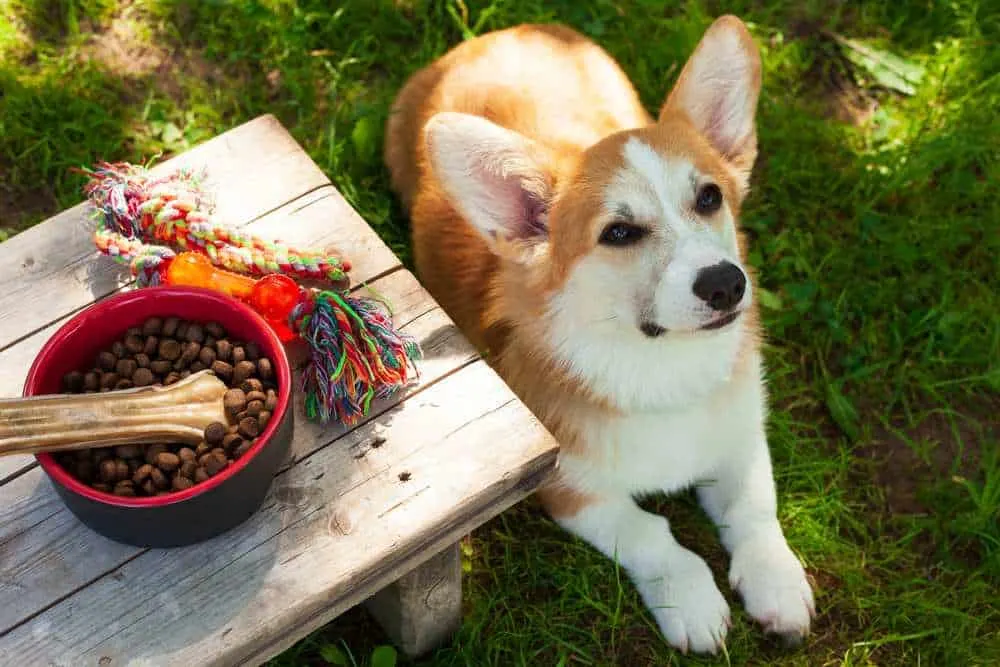
Corgi Care Tips
A corgi dog needs a lot of attention, from grooming tips to nourishment. You may feel overwhelmed at times and feel like you are forgetting something. Because of that, we are giving you the top corgi care tips:
- Always make time for your corgi: The corgi breed requires a lot of attention. They need to feel the love of their owner 24/7, and they will spend that much time with them. Female corgis can even be considered a bit territorial and show aggression if they feel threatened. Also, if you don’t spend a certain amount of time with your corgi on a daily basis, they can develop “separation anxiety”. This is a state of depression they fall into if they are not with their owner. Be careful. This doesn’t just affect the mental health of your corgi. It can also lead to some severe illnesses.
- Work on your corgi’s training continuously: Training is an essential part of your corgi’s life. It is true that they can be a bit harder to train, so that is why you have to be persistent and patient at the same time. Establishing a proper training routine while your corgi is still a puppy is the best way to avoid any inconveniences at a later age. They need constant attention, and it would be very beneficial for them if you decide to include some new tricks and commands from time to time.
- Take your corgi to the vet regularly: You will need to make frequent visits to the vet because your corgi is more prone to health issues than some other breeds. Also, before buying your corgi, make sure that the breeder took the necessary genetic tests because they will have an enormous influence on their life.
- Keep your corgi on a healthy diet: A corgi dog loves to eat, and they will munch on everything they find in front of them. But this doesn’t mean that they should eat that much food. They can gain a lot of weight really quickly, and their body shape can’t take it. So, it would be best if you were careful what you feed your corgi. Make sure that you include some vitamins and choose quality dog food.
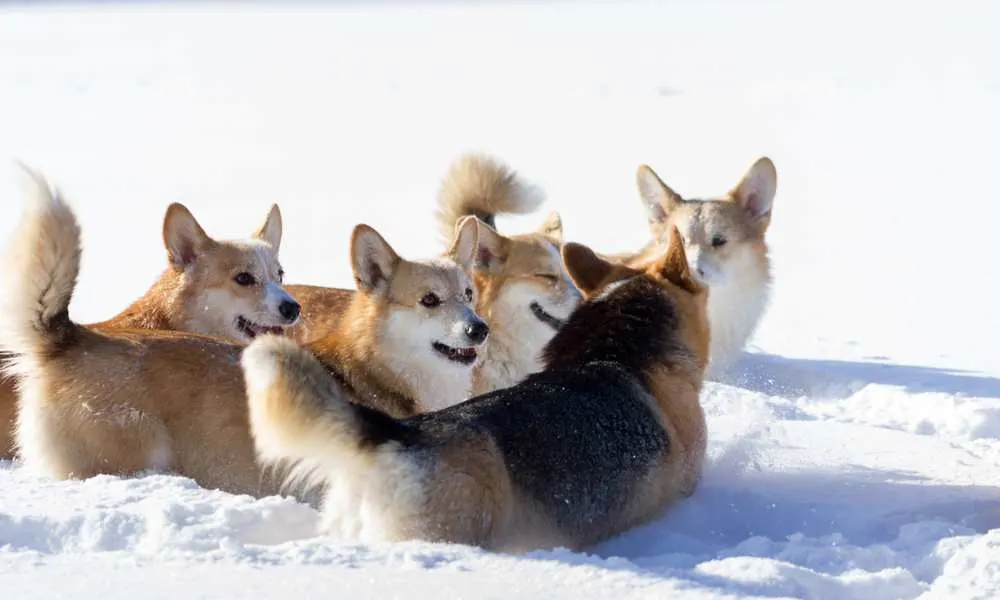
Conclusion
The corgi breed is blessed with a variety of different colors, and they all look beautiful. The two breeds, however, come in different shades. The five primary corgi colors are red, black, sable, blue, and brindle.
The Pembroke Welsh corgi comes in red, red-headed tri-color, black-headed tri-color, and sable. The three color mix in corgis applies to their ears, space around the eyes, and the top of their head. On the other hand, The Cardigan Welsh corgi comes in blue, blue merle, brindle, red, and sable.
Apart from the beautiful colors, there are also some markings that make them unique. Some corgis have a black mask or brindle points across their body, and others have noticeable white markings on their tummies.
To keep this coat nice and neat, you need to groom them regularly. Regular grooming involves examining the dog’s body, brushing, bathing, cleaning their teeth and ears, and nail clipping. You can find some additional equipment like quality dog shampoos or brushes on Amazon for reasonable prices. If you want a professional touch, you can take your corgi to the salon to get a fluffy, natural, or modest trim.
The corgi cattle dog is another corgi breed. This is a mixture of the Pembroke Welsh corgi and an Australian Cattle dog. Like its parents, this is a highly intelligent dog, and you can see it in the following colors: red, brown, blue, black, and white.
In order for your corgi to stay healthy and happy, you should take him to the vet regularly, keep him on a healthy diet and spend a lot of quality time with him.

